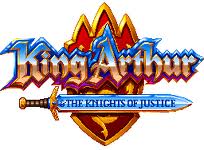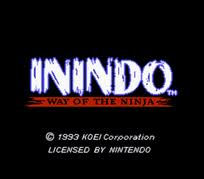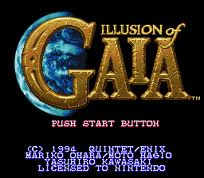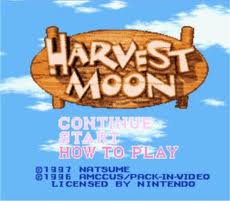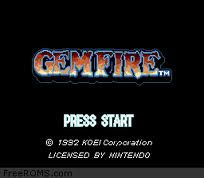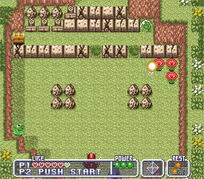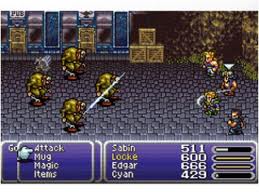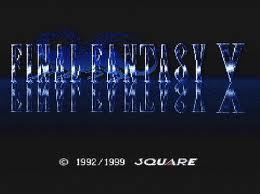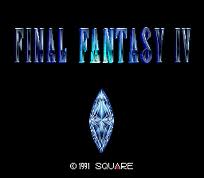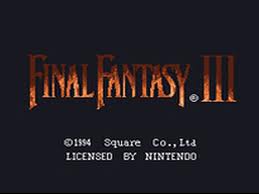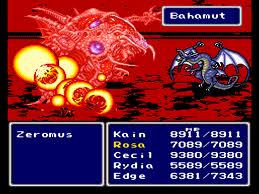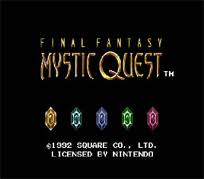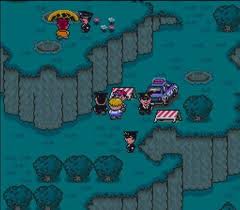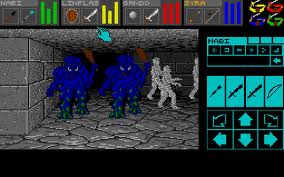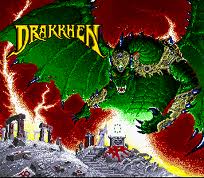Category: RPG
102 game(s)All RPG Games for SNES
King Arthur And The Knights Of Justice
King Arthur & the Knights of Justice is an action-adventure game developed by Manley & Associates and published by Enix for the Super Nintendo Entertainment System in May 1995. Based on the cartoon series of the same title, which was loosely inspired by the Arthurian legend, the game was released in North America exclusively.
The player takes on the role of a team of American football players who are transported to Medieval England and given the mission to save King Arthur from the evil sorceress Morgana and her army. The game was the first Enix title developed by an American company, and was inspired by The Legend of Zelda series and various written works. It was received with reviews ranging from mediocre to extremely poor.
Inindo : Way of the Ninja
Illusion of Gaia
Illusion of Gaia (ガイア幻想紀, Gaia Gensōki?, lit. "Records of the Illusion of Gaia"), known in Europe and Australia as Illusion of Time, is an action role-playing game that was released on September 1, 1994, for the Super NES. Developed by Quintet, Enix published the game in Japan, and Nintendo published it worldwide.
Illusion of Gaia was scored by Yasuhiro Kawasaki. Moto Hagio, the influential manga artist, is credited with the character designs. Novelist Mariko Ōhara worked on the story.
Harvest Moon
Harvest Moon (牧場物語 Bokujō Monogatari?) is a virtual role playing game for the Super Nintendo Entertainment System developed and published by Pack-In-Video (now Marvelous AQL), first released in Japan in 1996, and 1997 in North America. This is the first game in the long-running series of the same name. A PAL version was released by Nintendo in early 1998 for Western Europe and Oceania, with language localizations for Germany and France.
Gemfire
Gemfire (released in Japan as Royal Blood or ロイヤルブラッド Roiyaru Buraddo, Super Royal Blood or スーパーロイヤルブラッド Sūpā Roiyaru Buraddo in its Super Famicom version) is a medieval war game for the MSX, Nintendo Entertainment System, Super NES, FM Towns, Mega Drive/Genesis, MS-DOS, and later Windows, developed by Koei. The object in the game is to unify a fictional island by force. Players use soldiers and knights, as well as fantasy units such as magicians, dragons or gargoyles in order to capture the castle needed to control that particular territory.
A sequel, Royal Blood II, was released in the Japan market for Japanese Windows.
Firestriker
Firestriker (ホーリーストライカー?, lit. "Holy Striker") is an overhead view action video game that was released on December 17, 1993 in Japan and on October 1994 in North America exclusively for the Super Nintendo Entertainment System.
Final Fantasy VI
Final Fantasy VI (ファイナルファンタジーVI Fainaru Fantajī Shikkusu?) is a role-playing video game developed and published by Square (now Square Enix), released in 1994 for the SNES as a part of the Final Fantasy series. Set in a fantasy world with a technology level equivalent to that of the Second Industrial Revolution, the game's story focuses on a group of rebels as they seek to overthrow an imperial dictatorship. The game features fourteen permanent playable characters, the most of any game in the main series.
It was ported by Tose with minor differences to Sony's PlayStation in 1999 and Nintendo's Game Boy Advance in 2006, and it was released for the Wii's Virtual Console in Japan in March 15, 2011, followed by the PAL region on March 18, 2011 and North America on June 30, 2011. The game was known as Final Fantasy III when it was first released in North America, as the original Final Fantasy III had not been released outside of Japan at the time. However, most later localizations used the original title. Final Fantasy VI was the first game in the series to be directed by someone other than producer and series creator Hironobu Sakaguchi; the role was filled instead by Yoshinori Kitase and Hiroyuki Ito. Yoshitaka Amano, a long-time contributor to the Final Fantasy series, returned as the image and character designer, while regular composer Nobuo Uematsu wrote the game's score, which has been released on several soundtrack albums.
Released to critical acclaim, Final Fantasy VI was a landmark title for the role-playing genre and is often considered one of the greatest video games of all time. Its Super Nintendo and PlayStation versions have sold over 3.48 million copies worldwide to date as a stand-alone game, as well as over 750,000 copies as part of the Japanese Final Fantasy Collection and the North American Final Fantasy Anthology. Final Fantasy VI has won numerous awards since its release.
Final Fantasy V
Final Fantasy V (ファイナルファンタジーV Fainaru Fantajī Faibu?) is a medieval-fantasy role-playing video game developed and published by Square (now Square Enix) in 1992 as a part of the Final Fantasy series. The game first appeared only in Japan on Nintendo's Super Famicom (known internationally as the Super Nintendo Entertainment System). It has been ported with minor differences to Sony's PlayStation and Nintendo's Game Boy Advance. An original video animation produced in 1994 called Final Fantasy: Legend of the Crystals serves as a sequel to the events depicted in the game. It was released for the PlayStation Network on April 6, 2011 in Japan. An enhanced port of the game, with new high resolution graphics and touch-based interface, was released for iPhone and iPad on March 28, 2013 with Android released on September 25, 2013.
The game begins as a wanderer named Bartz investigates a fallen meteor. There, he encounters several characters, one of whom reveals the danger facing the four Crystals that control the world's elements. These Crystals act as a seal on Exdeath, an evil sorcerer. Bartz and his party must keep the Crystals from being exploited by Exdeath's influence and prevent his resurgence.
Final Fantasy V has been praised for the freedom of customization that the player has over the characters, achieved through the greatly expanded Job System. Despite being released only in Japan, the Super Famicom version sold more than two million copies. The PlayStation version has earned "Greatest Hits" status, selling more than 350,000 copies.
Final Fantasy IV
Final Fantasy IV (ファイナルファンタジーIV Fainaru Fantajī Fō?) is a role-playing video game developed and published by Square (now Square Enix) in 1991 as a part of the Final Fantasy series. The game was originally released for the Super Famicom in Japan and has since been rereleased for many other platforms with varying modifications. The game was re-titled Final Fantasy II during its initial release outside of Japan as the original Final Fantasy II and Final Fantasy III had not been released outside of Japan at the time. However, later localizations used the original title.
The game's story follows Cecil, a dark knight, as he tries to prevent the sorcerer Golbez from seizing powerful crystals and destroying the world. He is joined on this quest by a frequently changing group of allies. Final Fantasy IV introduced innovations that became staples of the Final Fantasy series and role-playing games in general. Its "Active Time Battle" system was used in five subsequent Final Fantasy games, and unlike prior games in the series, IV gave each character their own unchangeable character class.
With its character-driven plot, use of new technologies and critically acclaimed score by Nobuo Uematsu, Final Fantasy IV is regarded as a landmark of the series and the role-playing genre. The various incarnations of the game have sold more than four million copies worldwide. An enhanced remake, also called Final Fantasy IV, with 3D graphics was released for the Nintendo DS in 2007 and 2008. A sequel, Final Fantasy IV: The After Years, was released for Japanese mobile phones in 2008, and worldwide via the Wii Shop Channel on June 1, 2009. In 2011, both Final Fantasy IV and The After Years were released for the PlayStation Portable as part of the compilation Final Fantasy IV: The Complete Collection, which also included a new game, set between the two; Final Fantasy IV: Interlude. An iOS port of the Nintendo DS remake was released on December 20, 2012, as well as an Android version on June 4, 2013.
Final Fantasy III
Final Fantasy III (ファイナルファンタジーIII Fainaru Fantajī Surī?) is a role-playing video game developed and published by Square in 1990 for the Family Computer as the third installment in the Final Fantasy series. It is the first numbered Final Fantasy game to feature the job-change system.
The story revolves around four orphaned youths drawn to a crystal of light. The crystal grants them some of its power, and instructs them to go forth and restore balance to the world. Not knowing what to make of the crystal's pronouncements, but nonetheless recognizing the importance of its words, the four inform their adoptive families of their mission and set out to explore and bring back balance to the world.
The game was originally released in Japan on April 27, 1990. It had never been released outside of Japan until a remake was released on the Nintendo DS on August 24, 2006. At that time, it was the only Final Fantasy game not previously released in North America or Europe. There had been earlier plans to remake the game for Bandai's WonderSwan Color handheld, as had been done with the first, second, and fourth installments of the series, but the game faced several delays and was eventually canceled after the premature cancellation of the platform. The Nintendo DS version of the game was positively received internationally, selling over one million copies in Japan.
It was also released for the many other systems: the Japanese Virtual Console version (Famicom version) on July 21, 2009 (Wii) and January 8, 2014 (Wii U), an iOS port of the Nintendo DS remake on March 24, 2011, an Android version on March 12, 2012, a PlayStation Portable version on late September 2012 (Downloadable only version outside of Japan via PlayStation Network) and Android-based Ouya console on April 11, 2013.
Final Fantasy 2
Final Fantasy Mystic Quest
Final Fantasy Mystic Quest, released as Mystic Quest Legend in PAL regions and as Final Fantasy USA: Mystic Quest (ファイナルファンタジーUSA ミスティッククエスト Fainaru Fantajī Yū Esu Ē Misutikku Kuesuto?) in Japan, is a role-playing video game for the Super Nintendo Entertainment System. The game was released as a spin-off to Square's popular Final Fantasy series of video games. Final Fantasy Mystic Quest was first released in North America in 1992 and marketed as a "simplified role-playing game...designed for the entry-level player"[1] in an attempt to broaden the genre's appeal.[2] The game's presentation and battle system is broadly similar to that of the main series, but it differed in its inclusion of action-adventure game elements. Along with Final Fantasy Adventure, Final Fantasy Mystic Quest was the first Final Fantasy game to be released in Europe.
In the game, the player controls a youth named Benjamin in his quest to save the world. His goal is to reclaim a set of stolen crystals that determine the state of the world's four elemental powers. The gameplay takes a departure from the main series in a variety of ways. Many series staples are eliminated, such as random battles, save points, manual equipment, and the party system. The game received middling reviews and sales in North America and Japan, citing its simplified gameplay and lack of depth in the game's story. Over time, the game has kept the reputation for being a "beginner's Final Fantasy", but has been praised for its music.
Earthbound
EarthBound, also known as Mother 2: Gyiyg Strikes Back (Japanese: マザー2 ギーグの逆襲 Hepburn: Mazā Tsū: Gīgu no Gyakushū?)[1] in Japan and alternatively titled EarthBound: The War Against Giygas!, is a 1994 role-playing video game co-developed by Ape and HAL Laboratory and published by Nintendo for the Super Nintendo Entertainment System video game console. It is the second game in the EarthBound video game series, following the 1989 Japan-exclusive Mother. It was directed, produced, and written by series creator Shigesato Itoi. EarthBound was first released in Japan on August 27, 1994 and then in North America on June 5, 1995.
Despite its poor sales figures, the game has been lauded by gamers for its humorous depictions of American culture and parody of the role-playing video game genre,[2] and has since become a cult classic.[3] A sequel to EarthBound for the Nintendo 64DD, titled EarthBound 64, was in development for many years before finally being canceled.[4] This project later resurfaced as a Game Boy Advance title called Mother 3 and was released only in Japan.[5] A compilation video game containing both Mother and EarthBound was released in Japan as Mother 1 + 2.[6] EarthBound was re-released on the Wii U Virtual Console in Japan on March 20, 2013 and was released for North America and, for the first time, Europe and Australia, on July 18, 2013.
Dungeon Master
In the Dungeons & Dragons (D&D) role-playing game, the Dungeon Master (often abbreviated as DM) is the game organizer and participant in charge of creating the details and challenges of a given adventure, while maintaining a realistic continuity of events. In effect, the Dungeon Master controls all aspects of the game, except for the actions of the player characters, (PCs) and describes to the other players what they see and hear.
The title was invented for the TSR Dungeons & Dragons RPG, and was introduced in the second supplement to the game rules (Blackmoor). To avoid infringement of TSR's trademarks, and to describe referees in role-playing genres other than sword and sorcery, other gaming companies use more generic, terms, like Game Master, Game Operations Director, Judge, Referee or Storyteller, with some using more esoteric titles related to the genre or style of the game, such as Keeper of Arcane Lore, or even completely surreal titles such as Hollyhock God.
Also, in Faiths and Pantheons, the Faerunian Overgod Ao answers to a superior entity, insinuated to be the "Dungeon Master".
Drakkhen
Drakkhen is a 3D role-playing video game which was initially developed for the Amiga and Atari ST, and subsequently ported to several other platforms, including MS-DOS and the Super Nintendo Entertainment System.
Originally released by Infogrames in 1989, it was later modified for North American release by Draconian, a label from Data East, in 1990. Drakkhen was ported in 1991 to the Super Nintendo by Kemco-Seika, who made further revisions to the game.
Drakkhen was notable for being among the first role-playing games to feature a three-dimensional playing field. It did not employ a fully 3D game engine, instead implementing a hybrid approach using vectors and bitmapped character-scaling algorithms. Drakkhen features an animated day-night cycle, and the ability to wander freely about the game world, both rarities for a game of its era.
The game spawned a sequel, Dragon View, for the SNES.
